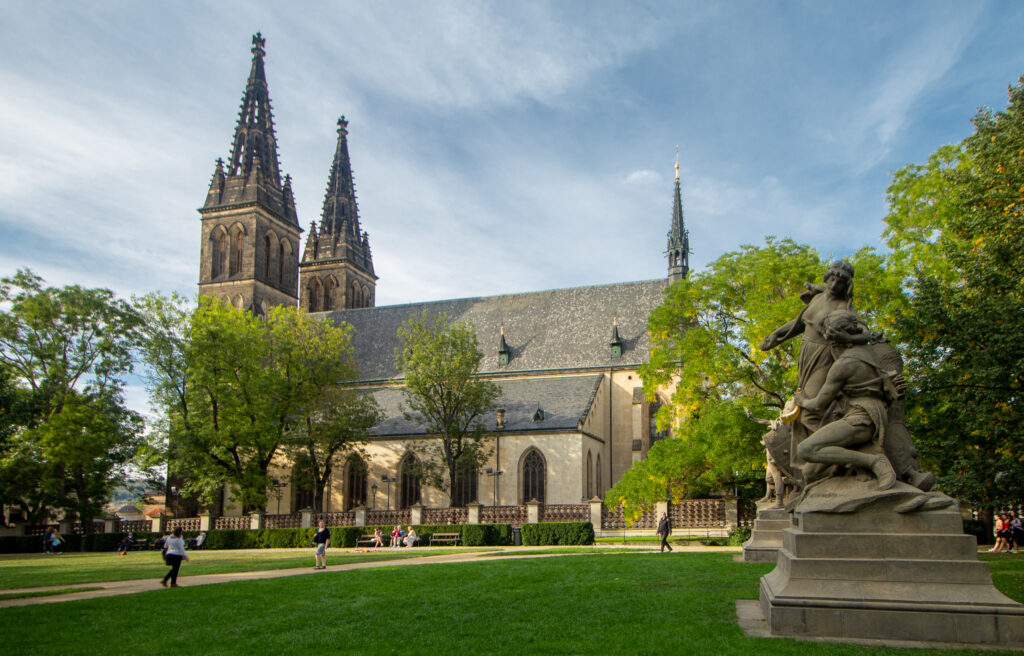
Vyšehrad, bazilika, credit Wikimedia Commons
Endnotes, April 2024
In this edition: Smetana from Prague – and some new discoveries. Reviewed by Stuart Millson.
New from the Pentatone label comes a brilliantly-recorded version of Bedrich Smetana’s six-movement symphonic cycle, Ma Vlast – My Country. A product of the romantic, Bohemian, folklore-inspired nationalism of the mid-1870s, the work is mainly known for its Vltava section, a depiction of the river that runs through what is now the Czech Republic. Yet for all the broad-themed radiance of this much-played excerpt (Radio 3’s Essential Classics, and Classic FM regularly feature it) – and it is one of the great orchestral highlights of the repertoire – Ma Vlast, in its other five parts, exhibits writing of enormous dramatic intensity, clarity and appealing harmony, every bit as compelling as Vltava.
In the hands of that master of detail, Semyon Bychkov, the Czech Philharmonic Orchestra (their musical bloodstream flowing from Smetana’s time) have set down on disc one of the truly great versions of this fascinating cycle of self-contained, yet belonging-to-one-another tone-poems. In the airy acoustic of the Dvorak Hall of the Rudolfinum in Prague, the orchestral playing emerges as if heralding a dream-sequence – the opening movement entitled Vyšehrad (The High Castle), offering a soft, bardic introduction played by solo harp. The listener is at once beckoned into a saga of heroes, long gone, in a landscape of legend. A Bohemian Camelot, ‘The High Castle’ looks out over the centuries, with the composer weaving a mediaeval musical tapestry, in which the flames of the fire in the banqueting hall seem to crackle into life once again.
The Czech Philharmonic seem to be more than simply ‘playing’ this music: instead, in the rich brew of orchestral sound, we begin to see a body of artists attending to a sacred ritual – divining, honouring, restoring a symphonic vision of their land. Smetana emerges from Ma Vlast as a composer, half in the Nature-light of Dvorak, but also partly in the forests of Wagnerian-type myth, or the shadows and uneasy tales associated later in the century with Mahler’s Das Klagende Lied. The tense string tremolo, for example, at the conclusion of the third tone-poem, Sarka, also lends a Brucknerian slant to the score – Sarka being a strange, disturbing tale of female beauty, infatuation and, at its conclusion, the night-time slaying of sleeping soldiers by warrior-maidens.
Following the success of their Mahler cycle (the Fourth Symphony, in particular, reaching rare heights of radiance), the Czech Philharmonic’s unveiling of their new Ma Vlast shows one of our great European orchestras at the peak of its power; a warmer glow to the performance style, perhaps, than in their old Eastern bloc days on the Supraphon label, yet still with that razor-sharp, sometimes ‘clipped’ phrasing. And in those parts of the score which require the deployment of the full, rounded power of a heavyweight orchestra, Bychkov achieves a pacing, tempered speed and ‘measure’ that truly enables the listener to savour Smetana’s heady and descriptive tableaux.
One tiny criticism, and this may seem unnecessarily pedantic, as it relates to the physical size and thus, the sound of the orchestra’s cymbals. On the one or two occasions in London when your reviewer obtained a ticket for the auditorium at which the Czechs are playing, my attention was drawn to the smaller-in-diameter size of this orchestra’s cymbals. These percussion instruments produce a sharp, metallic sound, but one that lacked the deeper ‘clash’ of the larger versions used by London orchestras. My feeling was that the Vltava movement, in its spectacular moments of triumph and grandeur, could have been intensified by a bigger percussion sound. A small point, granted, when one considers the thought and emotion that have gone into this fine reading of a favourite score.
A piece which might work well with Ma Vlast is a new overture by the contemporary composer, Nimrod Borenstein – the ballet overture, entitled Prayer to the Moon. With the lyricism of Dvorak, a sense of the wonder reminiscent of the opening of Mahler’s First Symphony, and a poignant, bittersweet ending evoking a Prokofiev Violin Concerto, Borenstein’s piece can be enjoyed on YouTube, performed by the Vratsa Symphony Orchestra of Bulgaria, conducted by the composer.
And from the United States to our QR Inbox (a recording not yet available to a wider audience) has come an audio file of a performance by the Buffalo Philharmonic conducted by JoAnn Falletta of Randall Svane’s Oboe Concerto, with soloist, Henry Ward. Romanticism in modern music is very much alive in the works of Randall Svane, and in this c. 20-minute piece, one almost feels that a new Vaughan Williams or Gerald Finzi has emerged into the world. We hope that a commercial recording will soon appear in the catalogues.
Finally, the rhythms of Latin America (and a fair measure, too, of sunshine-and-shadow South American Impressionism) are brought to life in an album of piano music, performed by Jose Navarro-Silberstein. The 20th-century Argentinian composer, Ginastera, opens the collection – his suite of dances offering a range of moods from an Allegro rustico, to a dreamy atmosphere (in the fourth movement) – Calmo e poetico. Lovers of the sunny Brazilian classicism of Villa-Lobos will luxuriate in the colours of the composer’s Ciclo brasileiro, written between 1936 and 37 – all captured by the impressive sound-engineering of the Genuin record label.
Stuart Millson is the Classical Music Editor of The Quarterly Review.
CD details; Smetana, Ma Vlast, Czech Philharmonic/Bychkov, Pentatone, PTC 5187 203.
Vibrant Rhythms – Ginastera, Villa Lobos et al, Genuin classics, GEN 23845.










